Summary: Managing kids’ screen time is a challenge many parents face, and there’s no one-size-fits-all solution. A recent Pew Research Center study highlights common habits and concerns, while The Verge staff and readers share their own strategies—from token systems and family viewing to intentional usage and content restrictions. Ultimately, it’s about finding what works best for your family.
What the Pew Research Study Revealed
This week, the Pew Research Center published a study exploring how parents manage screen time for children aged 12 and under. The findings weren’t particularly surprising: 90% of parents said their kids watch TV, 61% reported occasional smartphone use, and 50% allowed game console play. While 42% felt they could improve their management of screen time, 86% said they had rules in place—even if they didn’t always stick to them.
However, the study didn’t delve into the specifics of those rules—such as how long kids watch, what content they consume, or how parents ensure it’s appropriate.
Our Approach: A Token System for Screen Time
With my eight-year-old, we use a barter system inspired by Greg McKeown’s Essentialism. Each week, they start with 10 tokens, worth either $5 or five hours of screen time. They can earn extra time or money by reading. How they spend that time is mostly up to them—they might play Minecraft or watch shows on Disney+, Netflix, or Paramount+. They also have access to music-making apps and games on their iPad, but access isn’t unlimited.
To be clear, I’m not overly strict. My youngest gets about an hour of mostly educational TV daily, which helps me assist the oldest with homework. And every Saturday, we have a family movie night where we take turns choosing what to watch.
Family Screen Time as a Shared Experience
When I asked The Verge readers and staff about their screen time management, a common theme was making it a group activity. For example:
- Yw0 advised to “be around” when the TV is on, turning it into a shared experience.
- Kate Cox, senior producer for Decoder, has “Family Time” where they watch or play together. They’re currently rotating through Steven Universe, Batman: The Animated Series, and Final Fantasy 6, which helps kids engage with content they might have questions about or can’t do solo.
Screen Time Limits and Intentional Usage
Interestingly, the amount of time kids spend on screens wasn’t always the biggest concern—how they use that time mattered more. Time limits were common but not universal:
- Andrew Hawkins, Senior Transportation Editor, enforces a strict “no screens during the school week” rule.
- maverikJV limits their son to two hours of gaming on weekends and none during the week.
- Ostino allows two hours of computer time on weekdays but keeps PlayStations and Switches available.
- Smash Monocle limits iPad use to one hour daily but notes their kids don’t have free access, often going days without using them. Their focus is on intentional usage rather than bored browsing.
Concerns About Content and Social Media
Parents’ biggest worry was often what kids do with their screen time. Social media was a major concern, with 80% of Pew survey respondents saying it does more harm than good. Surprisingly, 15% said their kids used TikTok, while fewer used Instagram or Facebook (5%). About 74% watched YouTube with their children, but only 15% said their kids didn’t watch YouTube at all.
Many parents, myself included, don’t allow unsupervised YouTube access. Senior reviewer John Higgins only lets his son watch or play pre-approved content—Minecraft is allowed, but “definitely no Roblox (ever).” He also whitelists FaceTime contacts. Kate Cox describes her approach as “broadly very games-permissive but internet-restrictive,” excluding Roblox and YouTube.
Tools and Strategies for Managing Screen Time
When it comes to managing time, the simplest methods remain popular—taking devices away or pressing the power button. Some parents use Apple’s Screen Time feature to limit iPad usage specifically.
Phones and Older Kids
Phones aren’t common among younger kids. Pew found only 29% of parents allowed 8- to 10-year-olds to have their own smartphone. But usage increases with age:
- Abdulla77’s teenage daughter has an iPhone but can only call her parents outside specific hours.
- Krisprince prefers the Bark Phone for their 13-year-old because of its robust parental controls.
Final Thoughts
There’s no single right way to raise kids or manage screen time. What works for one family might not work for another. We’re all doing the best we can—58% of parents feel that way, according to Pew.
Follow topics and authors from this story to see more like this in your personalized homepage feed and receive email updates.
